Crafting a robust omnichannel marketing strategy has become increasingly imperative in the modern landscape.
As the realm of ecommerce continues to thrive, marketers are diligently striving to ensure seamless user experiences across all platforms. The evolution of consumer behavior indicates a significant shift wherein customers seamlessly transition between various devices while maintaining the contextual thread of their interactions. This cross-device interaction is pivotal, reflecting the trend of users completing tasks by seamlessly switching between multiple devices.
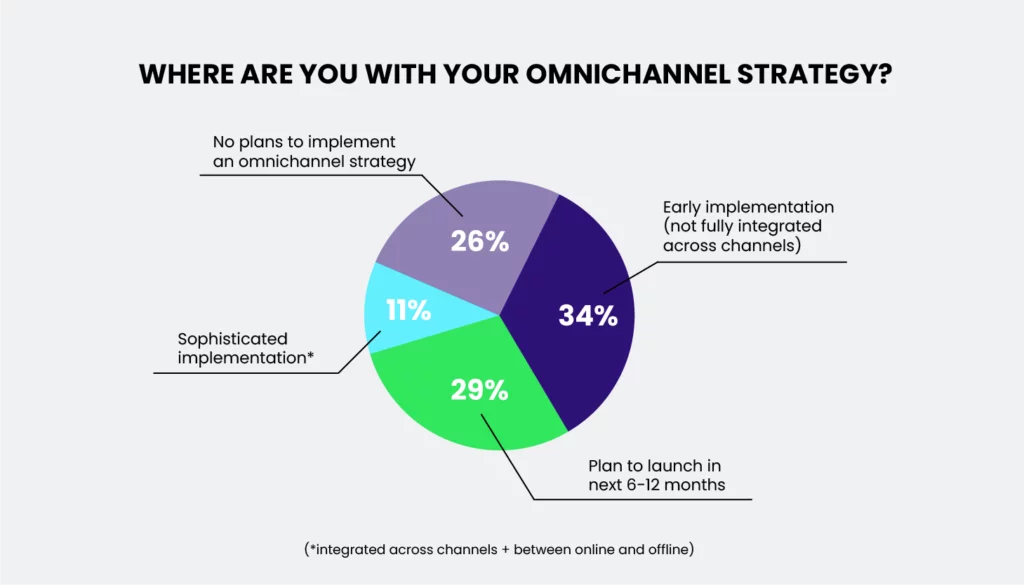
What is Omnichannel Marketing?
Omnichannel marketing revolves around the concept of creating a unified and uninterrupted user experience that spans across all touchpoints in a buyer’s journey towards making a purchase. Users engage with multiple devices, empowering them with seamless connectivity and control over their purchasing journey.
In the past, consumers typically explored a limited number of options online. However, contemporary behavior involves in-depth research conducted over time, across diverse locations, and through a myriad of media channels. These channels transcend the digital sphere, encompassing traditional mediums like newspapers, magazines, billboards, word-of-mouth, and even brick-and-mortar stores.
Today’s marketing landscape demands brands to acknowledge and adapt to the reality that customers interact with them anytime and anywhere. Whether it’s through mobile devices, a brand’s website or application, in physical stores, or via other mediums, a comprehensive marketing strategy needs to accommodate these diverse touchpoints to ensure a cohesive and impactful customer journey.
Approach to Omnichannel Marketing Strategy:
Developing an effective omnichannel marketing strategy requires a deliberate and phased approach for a seamless multichannel experience. Here are steps to guide your process:
1. Start Small with Single-Channel Campaigns:
Initiating your omnichannel strategy begins by identifying a specific customer need or challenge. This involves launching a targeted campaign that spans diverse channels, encompassing both online platforms and physical stores. The aim is to address this particular issue comprehensively across these touchpoints.
2. Narrow in on the Customer-Centric Approach:
A customer-centric approach is pivotal. Your campaign should revolve around fulfilling the needs or resolving the challenges faced by your buyers. Employ various strategies such as contests, blogs, or other suitable methods tailored to align with each touchpoint, ensuring they resonate with your audience.
3. Evaluate and Refine:
Post the initial campaign, thorough assessment is crucial. Delve into the metrics—customer interactions, feedback, and engagement levels—to understand the campaign’s success. This analysis guides refinement and improvement strategies, allowing for an optimized approach based on real customer response.
4. Expand to Comprehensive Omnichannel Integration:
Building on the success of the single-channel initiative, broaden your strategy. Integrate additional channels like social media and email marketing to extend your brand’s reach. This expansion aims to create a cohesive brand presence across diverse platforms, ensuring a unified customer experience.
5. Ensure Consistency and Cohesion:
Consistency is paramount. Maintaining uniform messaging, branding, and a seamless customer experience across all channels is crucial. This cohesive approach facilitates a smooth transition for customers navigating through various touchpoints, reinforcing brand identity at every interaction.
6. Utilize Data Insights for Optimization:
Leverage comprehensive data analytics to derive actionable insights into customer behaviors and preferences. These insights serve as the cornerstone for optimizing and tailoring your omnichannel strategy. By aligning your approach with customer preferences, you ensure more impactful engagement and better overall performance.
Enabling Effective Omnichannel Marketing for Your Business
As the global ecommerce landscape continuously evolves, navigating the marketing terrain necessitates adaptive strategies and a comprehensive approach across multiple channels. Here’s how to steer your brand towards successful omnichannel marketing:
1. Prioritize Content Accessibility: Content remains a linchpin in effective marketing. In today’s digital landscape, the emphasis lies on providing immediate, on-demand content. Ensure accessibility across devices, from live chat for customer support to engaging content for building customer loyalty.
2. Customer-Centric Data Insights: Gather customer data to understand their preferences and behaviors. Identify roadblocks hindering their journey and actively seek customer input to enhance engagement. Leverage ecommerce trends to target advertising and bridge online and offline channels for improved cross-channel sales.
3. Foster Integrated Teamwork: Overcome organizational silos by fostering teamwork among departments like marketing, product development, and IT. Collaboration ensures a seamless and unified approach that eliminates barriers across channels, leading to a positive customer experience.
4. Embrace Marketing Technology Integration: Integrate key marketing tools like customer relationship management (CRM), video/web conferencing solutions, analytics, and email service providers. These tools provide a consistent experience across channels, with CRM serving as the backbone tracking individual customer journeys.
5. Addressing Barriers: While recognizing the importance of omnichannel marketing, some businesses struggle with its implementation. Many admit uncertainty about executing multichannel strategies effectively.
Learn about content marketing here.
Challenges to Omnichannel Marketing Strategy:
The impediments preventing companies from effectively implementing omnichannel marketing strategies are multifaceted and revolve around a combination of limited knowledge and economic constraints.
- Insufficient Analytical Resources: Many companies struggle due to inadequate resources for analyzing and deciphering the vast amounts of data available. This scarcity of analytical tools and expertise hampers the ability to extract meaningful insights from the data.
- Challenges in Data Integration: Another hurdle lies in the complexities of integrating the diverse sets of data gathered from various sources. This challenge often results in fragmented data, hindering a cohesive view of customer interactions across channels.
- Communication Gaps Between Departments: Ineffective communication between marketing teams and sales departments further exacerbates the issue. Misaligned strategies and disjointed efforts prevent seamless collaboration, leading to inconsistent customer experiences.
- Lack of High-Level Support: Often, there’s a lack of buy-in from senior leadership, particularly in the C-Suite. Without adequate understanding or recognition of the value of omnichannel marketing, securing the necessary resources and commitment becomes challenging.
- Organizational Silos: Siloed organizational structures present a significant barrier. Departments operating in isolation create a lack of cohesion, hindering the deve.
Top Omnichannel Marketing Softwares:
1. MoEngage:
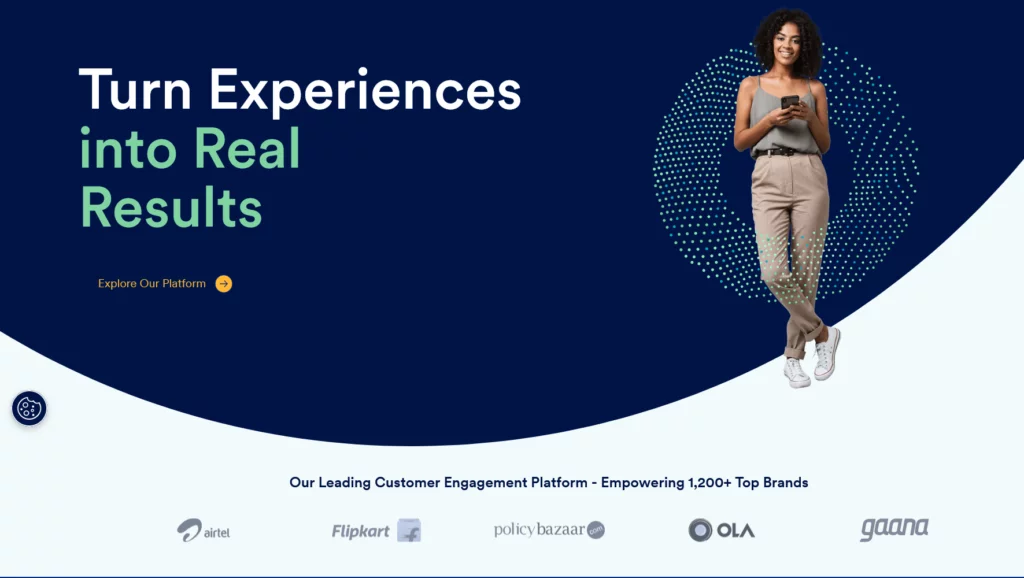
MoEngage stands as a comprehensive customer data platform meticulously designed to facilitate behavior analysis, multi-channel engagement, and touchpoint optimization. It caters to businesses seeking enhanced customer experiences through data-driven strategies.
MoEngage operates as a robust customer data platform, excelling in:
- Behavior Analysis: Offering sophisticated tools to deeply analyze and understand customer behavior across diverse touchpoints. This enables businesses to derive nuanced and comprehensive insights into user interactions and preferences.
- Multi-Channel Engagement: Providing an integrated approach to engaging customers across multiple channels. It ensures a cohesive and personalized communication strategy, enabling businesses to connect with their audience effectively.
- Touchpoint Optimization: Enabling businesses to optimize touchpoints based on the behavioral insights gathered. This capability allows for tailored and highly personalized customer interactions, aiming to improve engagement and conversion rates.
Pros:
- Holistic Insights: Offers comprehensive and detailed insights into customer behavior, crucial for crafting targeted marketing strategies.
- Unified Engagement: Facilitates seamless engagement across various channels, ensuring consistent and coherent customer experiences.
- Customized Optimization: Provides tools for touchpoint optimization, empowering businesses to enhance customer interactions.
Cons:
- Learning Curve: Its comprehensive features might require time for new users to fully grasp and utilize effectively.
- Integration Challenges: Integration with existing systems might pose technical complexities and require additional resources.
2. Omnisend:
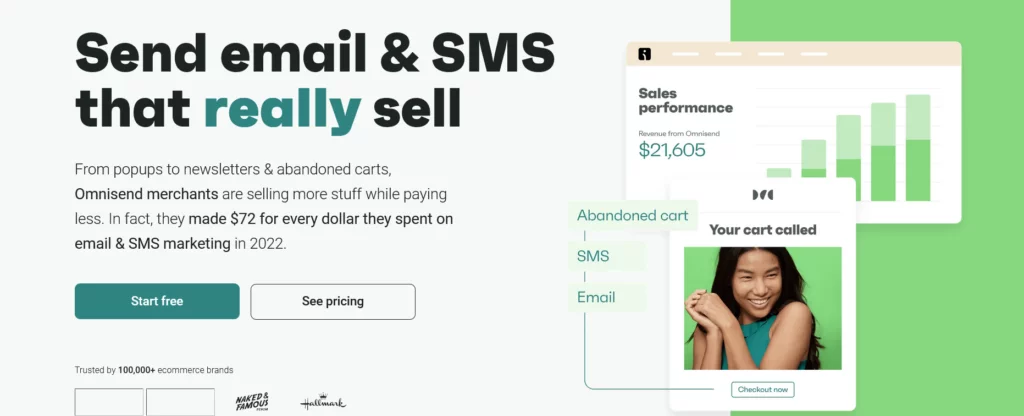
Omnisend is a unified digital marketing platform aimed at streamlining marketing operations across various digital channels. It offers a centralized hub for businesses to engage customers effectively.
Omnisend’s core strengths lie in:
- Unified Digital Channels: Offering a centralized platform that unifies multiple digital channels. It simplifies marketing efforts by allowing businesses to manage campaigns across various channels from a single interface.
- Automation Capabilities: Equipping businesses with robust automation tools that facilitate personalized and targeted marketing campaigns. This feature helps in optimizing customer engagement.
- Customer Insights: Providing valuable insights into customer behavior and preferences, enabling data-driven decision-making for tailored marketing strategies.
Pros:
- Efficient Operations: Streamlines marketing workflow by consolidating diverse digital channels into a single platform.
- Automation Strength: Offers robust automation capabilities, empowering businesses to create personalized campaigns.
- Data-Driven Approach: Provides valuable customer data for informed decision-making in marketing strategies.
Cons:
- Feature Limitations: Might lack some advanced functionalities found in more specialized platforms.
- Customization Constraints: Limited customization options might require workarounds for specific business needs.
3. Pyze:

Pyze is an advanced analytics and messaging platform known for its capability to deliver comprehensive insights and facilitate effective communication strategies. It serves as a vital tool for businesses seeking to understand user behavior deeply and optimize their communication to enhance user engagement.
Pyze offers several key functionalities:
- Comprehensive Analytics: Provides in-depth analytics to comprehend user behavior, patterns, and interactions across various touchpoints. This aids in gaining valuable insights into user preferences and engagement.
- Effective Communication: Offers robust messaging capabilities to engage users effectively. This includes personalized messaging, targeted notifications, and communication automation.
- Behavioral Segmentation: Utilizes advanced segmentation techniques to categorize users based on their behavior, allowing businesses to tailor communication strategies according to specific user segments.
Pros:
- Rich Analytics: Offers detailed and insightful analytics, aiding businesses in understanding user behavior comprehensively.
- Effective Communication Tools: Provides robust messaging features for personalized and targeted communication.
- Behavior-Based Segmentation: Enables businesses to segment users based on behavior, allowing for tailored communication strategies.
Cons:
- Complexity: The comprehensive set of features might require a learning curve for new users.
- Integration Challenges: Integration with existing systems may pose challenges and require technical expertise.
4. Ecrion Engage:

Ecrion Engage stands as communication software primarily designed to establish personalized connections with customers, thereby enhancing overall engagement levels. It is crafted to cater to businesses aiming for customized and impactful interactions with their customer base.
Ecrion Engage offers essential features such as:
- Personalized Communication: Provides tools and capabilities for businesses to craft personalized communication strategies, ensuring tailored interactions with customers.
- Enhanced Engagement: Focuses on enhancing engagement levels by enabling businesses to create personalized, targeted, and impactful communication that resonates with customers.
- Multi-Channel Communication: Supports communication across various channels, allowing businesses to reach customers through their preferred platforms.
Pros:
- Personalization Tools: Offers tools to facilitate highly personalized communication with customers, improving engagement.
- Focused Engagement: Concentrates on enhancing engagement levels through personalized and impactful communication strategies.
- Multi-Channel Reach: Allows businesses to communicate with customers through diverse channels for broader reach.
Cons:
- Feature Limitations: Might lack certain advanced features found in more comprehensive communication software.
- Integration Complexity: Integration with existing systems might require additional effort and technical expertise.
5. Clevertap:

Clevertap is a robust platform dedicated to the conversion, retention, and expansion of the mobile user base through the implementation of sophisticated analytics and engagement strategies. It stands as a comprehensive solution empowering businesses to optimize their mobile marketing efforts and maximize user engagement and retention.
Clevertap’s key features include:
- Advanced Analytics: Provides extensive analytics tools to deeply understand user behavior, preferences, and interactions within mobile applications. This enables businesses to make data-driven decisions to enhance their strategies.
- Engagement Strategies: Offers a wide array of engagement tools, such as push notifications, in-app messages, and personalized recommendations, facilitating effective communication and engagement with mobile users.
- User Segmentation: Employs robust segmentation capabilities to categorize users based on various attributes and behaviors, allowing businesses to create targeted and personalized campaigns.
Pros:
- Sophisticated Analytics: Offers advanced analytics tools for comprehensive insights into user behavior and preferences.
- Effective Engagement Features: Provides a diverse set of engagement tools to interact with users in personalized and targeted ways.
- Segmentation Capabilities: Empowers businesses with powerful segmentation for precise targeting and tailored campaigns.
Cons:
- Learning Curve: Due to its extensive feature set, mastering the platform might require a learning curve.
- Integration Challenges: Integration with existing systems may require technical expertise.
6. NotifyVisitors:
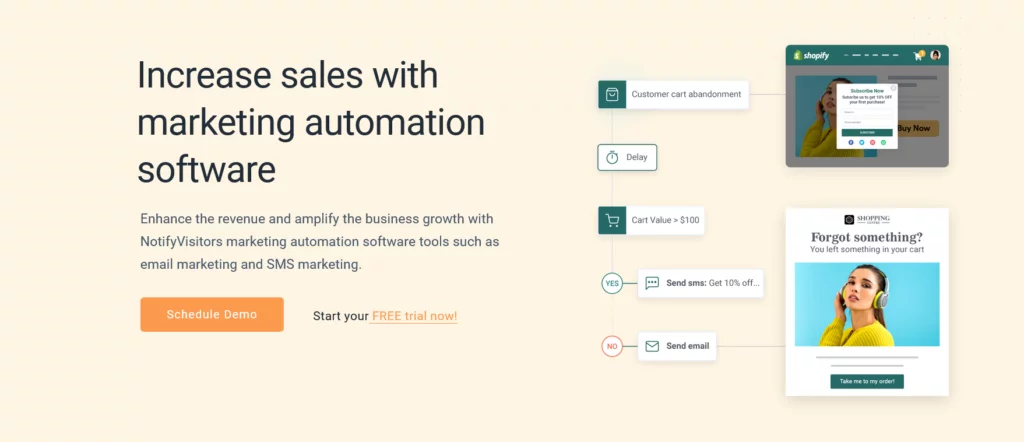
NotifyVisitors is a versatile marketing automation software designed to cater to diverse marketing needs across multiple channels. It serves as a comprehensive solution empowering businesses to streamline and optimize their marketing efforts while engaging with their audience effectively.
Key features of NotifyVisitors include:
- Multi-Channel Automation: Allows businesses to automate marketing processes across various channels like email, SMS, web push, in-app notifications, etc., ensuring a holistic approach to engagement.
- Personalization: Offers robust personalization tools that enable businesses to deliver tailored and customized content to their audience, enhancing user experience and engagement.
- Analytics and Insights: Provides analytics tools to track and measure the performance of campaigns, allowing businesses to optimize strategies based on real-time insights.
Pros:
- Multi-Channel Capabilities: Enables marketing automation across diverse channels for comprehensive reach.
- Personalization Tools: Offers robust features for creating personalized and tailored marketing campaigns.
- Analytics and Optimization: Provides analytics tools for tracking campaign performance and optimizing marketing strategies.
Cons:
- Complexity in Set-up: Initial setup and configuration might be complex for users new to the platform.
- Feature Depth: Some advanced features might require a learning curve for full utilization.
7. Zaius:
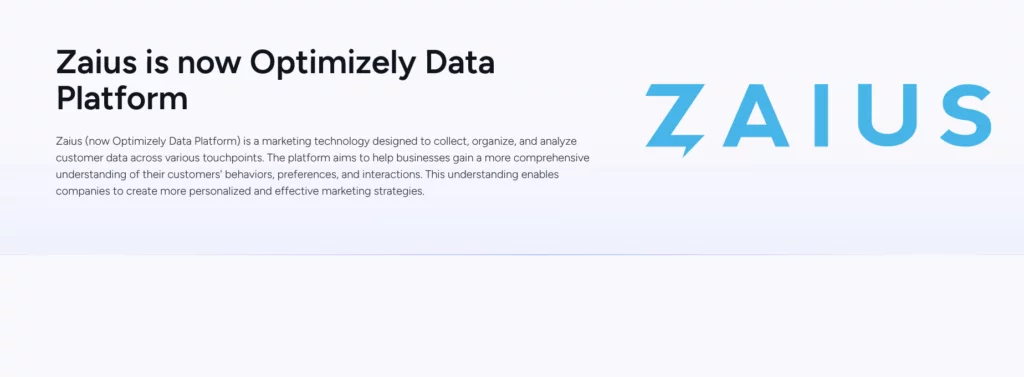
Zaius is an innovative platform that seamlessly integrates customer data to power dynamic marketing campaigns aimed at personalized engagement. It serves as a bridge between customer data and marketing strategies, allowing businesses to create highly tailored campaigns for enhanced engagement and conversions.
Key features of Zaius include:
- Unified Customer View: Zaius consolidates customer data from various sources into a single unified view, providing a holistic understanding of customer behavior and preferences.
- Dynamic Marketing Campaigns: Enables the creation of highly personalized and dynamic marketing campaigns based on real-time customer data, ensuring targeted and effective engagement.
- Cross-Channel Integration: Facilitates seamless integration across multiple marketing channels, allowing businesses to orchestrate cohesive and synchronized campaigns.
Pros:
- Unified Customer Insights: Offers a consolidated view of customer data for deeper insights and understanding.
- Personalized Campaigns: Enables the creation of tailored marketing campaigns based on real-time customer behavior.
- Cross-Channel Integration: Facilitates coordinated campaigns across various marketing channels for consistent messaging.
Cons:
- Integration Complexity: Setting up and integrating various data sources may require technical expertise.
- Learning Curve: Utilizing all the advanced features effectively might take time and training.
8. CustomerLabs CDP:
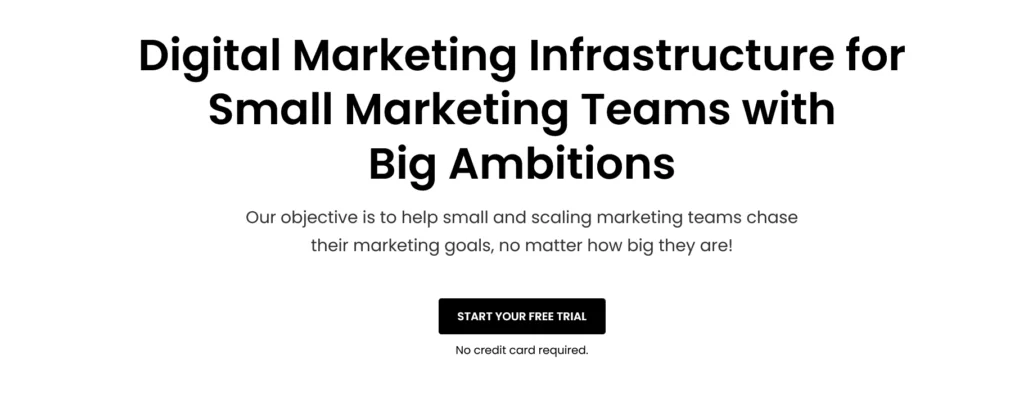
CustomerLabs CDP (Customer Data Platform) is a comprehensive analytics tool empowering businesses with in-depth customer analytics to drive data-backed strategies. It stands as a powerful solution for understanding customer behavior and leveraging data for strategic decision-making.
Key features of CustomerLabs CDP include:
- Customer Analytics: Provides robust analytics tools to track and analyze customer behavior, preferences, and interactions across various touchpoints.
- Segmentation and Targeting: Offers segmentation capabilities to categorize customers into specific groups based on their behavior, enabling targeted marketing strategies.
- Data-Driven Decision Making: Empowers businesses to make informed decisions backed by data-driven insights extracted from customer analytics.
Pros:
- Comprehensive Customer Insights: Offers extensive analytics tools for a deeper understanding of customer behavior.
- Segmentation Capabilities: Allows businesses to create targeted marketing strategies by segmenting customers based on behavior.
- Data-Driven Decisions: Facilitates strategic decision-making based on valuable customer insights.
Cons:
- Complexity in Implementation: Initial setup and integration may be complex for users without technical expertise.
- Feature Utilization: Maximizing the use of all advanced features might require training and familiarity with the platform.
9. Vizury:
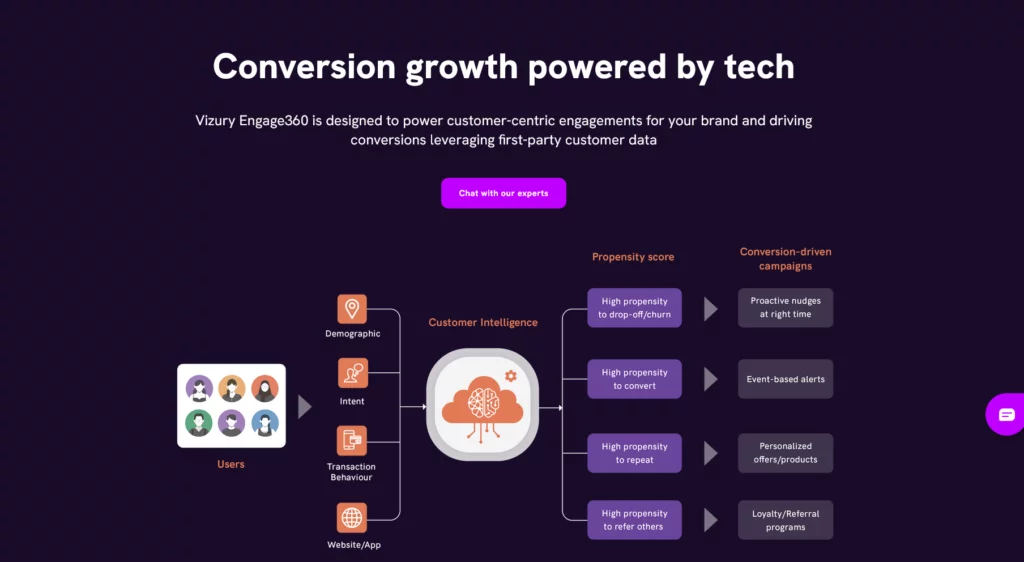
Vizury provides a comprehensive suite of solutions catering to customer acquisition, retention (customer loyalty), engagement, and conversion. It focuses on empowering businesses with tools and strategies to effectively engage customers across the entire lifecycle.
Key components of Vizury include:
- Customer Acquisition: Strategies and tools aimed at acquiring new customers through targeted marketing and outreach campaigns.
- Retention & Loyalty: Solutions to foster customer loyalty, encouraging repeat purchases and long-term engagement.
- Engagement & Conversion: Tools designed to engage customers effectively and optimize conversion rates for improved sales.
Pros:
- End-to-End Solutions: Offers a holistic suite covering all aspects of the customer journey, from acquisition to retention and conversion.
- Targeted Strategies: Provides tools for targeted and personalized marketing strategies to enhance customer engagement.
- Comprehensive Approach: Addresses various facets of customer relationships, streamlining marketing efforts.
Cons:
- Implementation Challenges: Integration and setup might pose challenges for businesses with complex systems or limited technical expertise.
- Learning Curve: Utilizing all features effectively might require a learning curve for new users.
Conclusion:
Embracing an omnichannel marketing strategy is crucial in today’s interconnected landscape. It allows businesses to meet customers wherever they are, providing a seamless and consistent experience across various touchpoints. By integrating multiple channels cohesively, businesses can enhance engagement, build stronger relationships, and drive conversions.
FAQs on Omnichannel Marketing Strategy:
What role does technology play in an effective omnichannel strategy?
Technology serves as a backbone, aiding in data analysis, channel integration, automation, and providing tools for personalized customer engagement.
How does an omnichannel strategy impact customer loyalty?
It enhances customer loyalty by offering a consistent and convenient experience, meeting customer expectations, and building stronger relationships through personalized interactions.
What are the key components of a successful omnichannel strategy?
A successful strategy involves a customer-centric approach, seamless integration of channels, data-driven insights, personalized communication, and a cohesive customer journey.
How can businesses measure the success of their omnichannel strategy?
Metrics such as customer satisfaction, sales conversions, engagement rates, retention, and feedback analysis help measure the success and effectiveness of an omnichannel approach.



